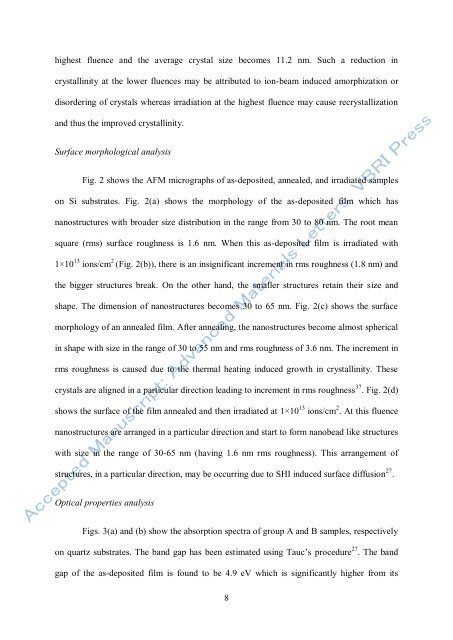Modification of nanocrystalline rf sputtered tin oxide thin film using ...
Modification of nanocrystalline rf sputtered tin oxide thin film using ...
Modification of nanocrystalline rf sputtered tin oxide thin film using ...
You also want an ePaper? Increase the reach of your titles
YUMPU automatically turns print PDFs into web optimized ePapers that Google loves.
highest fluence and the average crystal size becomes 11.2 nm. Such a reduction in<br />
crystallinity at the lower fluences may be attributed to ion-beam induced amorphization or<br />
disordering <strong>of</strong> crystals whereas irradiation at the highest fluence may cause recrystallization<br />
and thus the improved crystallinity.<br />
Su<strong>rf</strong>ace morphological analysis<br />
Fig. 2 shows the AFM micrographs <strong>of</strong> as-deposited, annealed, and irradiated samples<br />
on Si substrates. Fig. 2(a) shows the morphology <strong>of</strong> the as-deposited <strong>film</strong> which has<br />
nanostructures with broader size distribution in the range from 30 to 80 nm. The root mean<br />
square (rms) su<strong>rf</strong>ace roughness is 1.6 nm. When this as-deposited <strong>film</strong> is irradiated with<br />
1×10 13 ions/cm 2 (Fig. 2(b)), there is an insignificant increment in rms roughness (1.8 nm) and<br />
the bigger structures break. On the other hand, the smaller structures retain their size and<br />
shape. The dimension <strong>of</strong> nanostructures becomes 30 to 65 nm. Fig. 2(c) shows the su<strong>rf</strong>ace<br />
morphology <strong>of</strong> an annealed <strong>film</strong>. After annealing, the nanostructures become almost spherical<br />
in shape with size in the range <strong>of</strong> 30 to 55 nm and rms roughness <strong>of</strong> 3.6 nm. The increment in<br />
rms roughness is caused due to the thermal hea<strong>tin</strong>g induced growth in crystallinity. These<br />
crystals are aligned in a particular direction leading to increment in rms roughness 37 . Fig. 2(d)<br />
shows the su<strong>rf</strong>ace <strong>of</strong> the <strong>film</strong> annealed and then irradiated at 1×10 13 ions/cm 2 . At this fluence<br />
nanostructures are arranged in a particular direction and start to form nanobead like structures<br />
with size in the range <strong>of</strong> 30-65 nm (having 1.6 nm rms roughness). This arrangement <strong>of</strong><br />
structures, in a particular direction, may be occurring due to SHI induced su<strong>rf</strong>ace diffusion 27 .<br />
Optical properties analysis<br />
Figs. 3(a) and (b) show the absorption spectra <strong>of</strong> group A and B samples, respectively<br />
on quartz substrates. The band gap has been estimated <strong>using</strong> Tauc’s procedure 27 . The band<br />
gap <strong>of</strong> the as-deposited <strong>film</strong> is found to be 4.9 eV which is significantly higher from its<br />
8
















